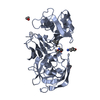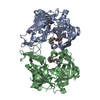[English] 日本語
 Yorodumi
Yorodumi- PDB-3fns: Crystal structure of histo-aspartic protease (HAP) from Plasmodiu... -
+ Open data
Open data
- Basic information
Basic information
| Entry | Database: PDB / ID: 3fns | ||||||
|---|---|---|---|---|---|---|---|
| Title | Crystal structure of histo-aspartic protease (HAP) from Plasmodium Falciparum | ||||||
 Components Components | HAP protein | ||||||
 Keywords Keywords |  HYDROLASE / Histo-aspartic protease / HAP / HYDROLASE / Histo-aspartic protease / HAP /  Plasmepsin / Plasmepsin /  Aspartic protease / Aspartic protease /  HORMONE HORMONE | ||||||
| Function / homology |  Function and homology information Function and homology informationMHC class II antigen presentation /  plasmepsin II / acquisition of nutrients from host / Neutrophil degranulation / vacuolar lumen / plasmepsin II / acquisition of nutrients from host / Neutrophil degranulation / vacuolar lumen /  food vacuole / aspartic-type endopeptidase activity / food vacuole / aspartic-type endopeptidase activity /  proteolysis / proteolysis /  membrane membraneSimilarity search - Function | ||||||
| Biological species |   Plasmodium falciparum 3D7 (eukaryote) Plasmodium falciparum 3D7 (eukaryote) | ||||||
| Method |  X-RAY DIFFRACTION / X-RAY DIFFRACTION /  SYNCHROTRON / SYNCHROTRON /  MOLECULAR REPLACEMENT / Resolution: 2.5 Å MOLECULAR REPLACEMENT / Resolution: 2.5 Å | ||||||
 Authors Authors | Bhaumik, P. / Gustchina, A. / Wlodawer, A. | ||||||
 Citation Citation |  Journal: J.Mol.Biol. / Year: 2009 Journal: J.Mol.Biol. / Year: 2009Title: Crystal structures of the histo-aspartic protease (HAP) from Plasmodium falciparum. Authors: Bhaumik, P. / Xiao, H. / Parr, C.L. / Kiso, Y. / Gustchina, A. / Yada, R.Y. / Wlodawer, A. | ||||||
| History |
|
- Structure visualization
Structure visualization
| Structure viewer | Molecule:  Molmil Molmil Jmol/JSmol Jmol/JSmol |
|---|
- Downloads & links
Downloads & links
- Download
Download
| PDBx/mmCIF format |  3fns.cif.gz 3fns.cif.gz | 142.7 KB | Display |  PDBx/mmCIF format PDBx/mmCIF format |
|---|---|---|---|---|
| PDB format |  pdb3fns.ent.gz pdb3fns.ent.gz | 111.4 KB | Display |  PDB format PDB format |
| PDBx/mmJSON format |  3fns.json.gz 3fns.json.gz | Tree view |  PDBx/mmJSON format PDBx/mmJSON format | |
| Others |  Other downloads Other downloads |
-Validation report
| Arichive directory |  https://data.pdbj.org/pub/pdb/validation_reports/fn/3fns https://data.pdbj.org/pub/pdb/validation_reports/fn/3fns ftp://data.pdbj.org/pub/pdb/validation_reports/fn/3fns ftp://data.pdbj.org/pub/pdb/validation_reports/fn/3fns | HTTPS FTP |
|---|
-Related structure data
| Related structure data |  3fntC  3fnuC  2anlS C: citing same article ( S: Starting model for refinement |
|---|---|
| Similar structure data |
- Links
Links
- Assembly
Assembly
| Deposited unit | 
| ||||||||||||||||||
|---|---|---|---|---|---|---|---|---|---|---|---|---|---|---|---|---|---|---|---|
| 1 |
| ||||||||||||||||||
| Unit cell |
| ||||||||||||||||||
| Noncrystallographic symmetry (NCS) | NCS domain:
NCS domain segments: Component-ID: 1 / Ens-ID: 1 / Beg auth comp-ID: GLU / Beg label comp-ID: GLU / End auth comp-ID: LYS / End label comp-ID: LYS / Refine code: 4 / Auth seq-ID: 0 - 326 / Label seq-ID: 6 - 330
| ||||||||||||||||||
| Details | Two molecules of histo-aspartic protease (HAP) are present in the asymmetric unit. Two molecules form a tight dimer related by a non-crystallographic symmetry. |
- Components
Components
| #1: Protein | Mass: 37435.250 Da / Num. of mol.: 2 / Fragment: Histo-aspartic protease (HAP) Source method: isolated from a genetically manipulated source Source: (gene. exp.)   Plasmodium falciparum 3D7 (eukaryote) / Gene: HAP, PF14_0078 / Plasmid: pET32b(+) / Production host: Plasmodium falciparum 3D7 (eukaryote) / Gene: HAP, PF14_0078 / Plasmid: pET32b(+) / Production host:   Escherichia coli (E. coli) / Strain (production host): Rosetta-gami B (DE3)pLysS / References: UniProt: Q8IM15 Escherichia coli (E. coli) / Strain (production host): Rosetta-gami B (DE3)pLysS / References: UniProt: Q8IM15#2: Chemical | ChemComp-ZN / #3: Water | ChemComp-HOH / |  Water Water |
|---|
-Experimental details
-Experiment
| Experiment | Method:  X-RAY DIFFRACTION / Number of used crystals: 1 X-RAY DIFFRACTION / Number of used crystals: 1 |
|---|
- Sample preparation
Sample preparation
| Crystal | Density Matthews: 2.68 Å3/Da / Density % sol: 54.02 % Description: AUTHORS STATE THAT THE VALUE OF RMERGE IN THE HIGHEST RESOLUTION SHELL IS HIGH DUE TO POORLY DIFFRACTING CRYSTAL/HIGH SYMMETRY SPACE GROUP/ HIGHLY REDUNDANT DATA. CRYSTAL HAS SUFFERED SOME RADIATION DAMAGE |
|---|---|
Crystal grow | Temperature: 293 K / Method: vapor diffusion, hanging drop / pH: 4.5 Details: 10% PEG 3000, 0.2M Zinc acetate, 0.1M sodium acetate pH 4.5, VAPOR DIFFUSION, HANGING DROP, temperature 293K |
-Data collection
| Diffraction | Mean temperature: 100 K |
|---|---|
| Diffraction source | Source:  SYNCHROTRON / Site: SYNCHROTRON / Site:  APS APS  / Beamline: 22-ID / Wavelength: 0.99999 Å / Beamline: 22-ID / Wavelength: 0.99999 Å |
| Detector | Type: MARMOSAIC 300 mm CCD / Detector: CCD / Date: Feb 14, 2008 |
| Radiation | Protocol: SINGLE WAVELENGTH / Monochromatic (M) / Laue (L): M / Scattering type: x-ray |
| Radiation wavelength | Wavelength : 0.99999 Å / Relative weight: 1 : 0.99999 Å / Relative weight: 1 |
| Reflection | Resolution: 2.5→40 Å / Num. all: 28973 / Num. obs: 28895 / % possible obs: 99.7 % / Redundancy: 9.5 % / Rmerge(I) obs: 0.093 |
| Reflection shell | Resolution: 2.5→2.6 Å / Redundancy: 9.7 % / Rmerge(I) obs: 0.822 / Mean I/σ(I) obs: 3.1 / Num. unique all: 3120 / % possible all: 99.6 |
- Processing
Processing
| Software |
| |||||||||||||||||||||||||||||||||||||||||||||||||||||||||||||||||
|---|---|---|---|---|---|---|---|---|---|---|---|---|---|---|---|---|---|---|---|---|---|---|---|---|---|---|---|---|---|---|---|---|---|---|---|---|---|---|---|---|---|---|---|---|---|---|---|---|---|---|---|---|---|---|---|---|---|---|---|---|---|---|---|---|---|---|
| Refinement | Method to determine structure : :  MOLECULAR REPLACEMENT MOLECULAR REPLACEMENTStarting model: 2ANL Resolution: 2.5→30 Å / Cor.coef. Fo:Fc: 0.932 / Cor.coef. Fo:Fc free: 0.911 / SU B: 10.239 / SU ML: 0.233 / Cross valid method: THROUGHOUT / ESU R: 0.5 / ESU R Free: 0.3 / Stereochemistry target values: MAXIMUM LIKELIHOOD
| |||||||||||||||||||||||||||||||||||||||||||||||||||||||||||||||||
| Solvent computation | Ion probe radii: 0.8 Å / Shrinkage radii: 0.8 Å / VDW probe radii: 1.2 Å / Solvent model: MASK | |||||||||||||||||||||||||||||||||||||||||||||||||||||||||||||||||
| Displacement parameters | Biso mean: 51.33 Å2
| |||||||||||||||||||||||||||||||||||||||||||||||||||||||||||||||||
| Refinement step | Cycle: LAST / Resolution: 2.5→30 Å
| |||||||||||||||||||||||||||||||||||||||||||||||||||||||||||||||||
| Refine LS restraints |
| |||||||||||||||||||||||||||||||||||||||||||||||||||||||||||||||||
| Refine LS restraints NCS | Dom-ID: 1 / Auth asym-ID: A / Ens-ID: 1 / Number: 2591 / Refine-ID: X-RAY DIFFRACTION
| |||||||||||||||||||||||||||||||||||||||||||||||||||||||||||||||||
| LS refinement shell | Resolution: 2.5→2.565 Å / Total num. of bins used: 20
|
 Movie
Movie Controller
Controller










 PDBj
PDBj


